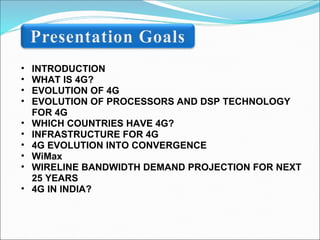4 G Presentation
- 2. • INTRODUCTION • WHAT IS 4G? • EVOLUTION OF 4G • EVOLUTION OF PROCESSORS AND DSP TECHNOLOGY FOR 4G • WHICH COUNTRIES HAVE 4G? • INFRASTRUCTURE FOR 4G • 4G EVOLUTION INTO CONVERGENCE • WiMax • WIRELINE BANDWIDTH DEMAND PROJECTION FOR NEXT 25 YEARS • 4G IN INDIA?
- 3. • 4G, the successor of 3G, will soon become the standard for cellular wireless • The technology is currently available in some countries but it is still being perfected • The aim is to achieve “ultra broadband speed” – to be counted in gigabytes per second
- 4. • ITU designed 4G in 2002 with the official name “3G Long-Term Evolutions” or 3.9G • Will allow users to download a full-length feature film within five minutes • Will also be able to stream high-definition television and radio to hand-held devices • The basic difference between 3G and 4G is in data transfer and signal quality
- 5. • The highest download and upload speed in 3G are 14 Mbps and 5.8 Mbps respectively • In 4G the download speed is up to 100 Mbps for moving users and 1 Gbps for stationary users • 4G is adoption of packet switching instead of circuit switching in voice and video calls • With packet switching, resources are only used when there is information to be sent across • 4G uses spiral multiplexing
- 6. • The first commercial deployment was by Telia Sonera and NetCom • Telia Sonera branded the network “4G” • The modem devices on offer were manufactured by Samsung (dongle GT-B3710) • The network infrastructure were created by Huawei (in Oslo) and Ericsson (in Stockholm)
- 8. • Except for the Scandinavian countries, a few countries have started the 4G commercially • In the US, Sprint Nextel initiated the service last year • Countries expected to launch 4G by this year are Germany, Spain, China, Japan and England
- 9. • There are three primary technologies that support 4G – WiMax, LTE, and UMB • The main doubt is whether to implement WiMax or LTE • The advantages of LTE are: (i) Faster speed with 100 Mbps for download and 50 Mbps for upload (ii) It makes CDMA and GSM database moot (iii) It offers both FDD and TDD duplexing
- 11. • WiMax technology might not achieve the required rate in a high-density area • However, WiMax technology becomes useful when it is bundled with IPTV • The wireless bandwidth will be roughly 3Mbps/1.5Mbps; but this is nowhere near the +100Mbps/50Mbps that LTE promises
- 13. • Has already begun the process of introducing 4G • India is among the latecomers in 3G • It is felt that by the time to implement 3G fully, 4G technologies such as LTE will be available commercially • It has taken three years for the government to decide on 3G-spectrum auction policy • 4G could face the same delay unless India wants to catch up with the rest of the world













